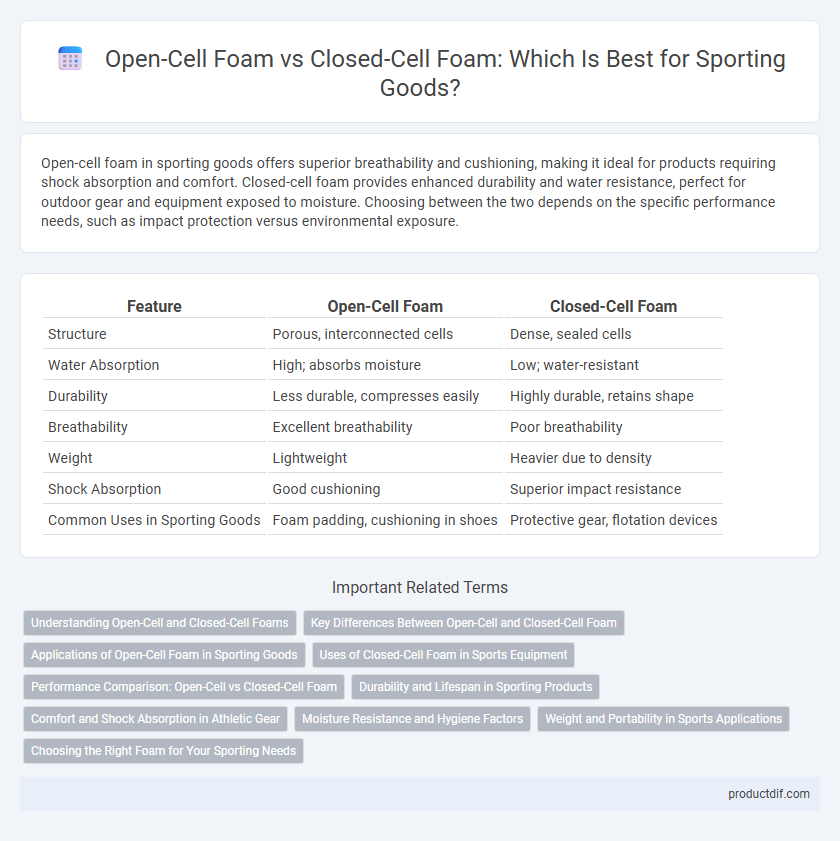Open-cell foam in sporting goods offers superior breathability and cushioning, making it ideal for products requiring shock absorption and comfort. Closed-cell foam provides enhanced durability and water resistance, perfect for outdoor gear and equipment exposed to moisture. Choosing between the two depends on the specific performance needs, such as impact protection versus environmental exposure.
Table of Comparison
| Feature | Open-Cell Foam | Closed-Cell Foam |
|---|---|---|
| Structure | Porous, interconnected cells | Dense, sealed cells |
| Water Absorption | High; absorbs moisture | Low; water-resistant |
| Durability | Less durable, compresses easily | Highly durable, retains shape |
| Breathability | Excellent breathability | Poor breathability |
| Weight | Lightweight | Heavier due to density |
| Shock Absorption | Good cushioning | Superior impact resistance |
| Common Uses in Sporting Goods | Foam padding, cushioning in shoes | Protective gear, flotation devices |
Understanding Open-Cell and Closed-Cell Foams
Open-cell foam features a porous structure with interconnected cells that absorb shock and provide superior cushioning, ideal for sports equipment requiring comfort and impact absorption. Closed-cell foam has tightly packed, sealed cells that repel water and offer higher density, making it perfect for durable, water-resistant sporting goods like protective padding and flotation devices. Understanding the structural differences between open-cell and closed-cell foams helps select the optimal material for specific athletic applications.
Key Differences Between Open-Cell and Closed-Cell Foam
Open-cell foam features a porous structure that allows air and moisture to pass through, offering superior breathability and cushioning, making it ideal for comfort-focused sporting goods like insoles and padding. Closed-cell foam has a dense, non-porous structure that provides excellent water resistance, durability, and impact absorption, commonly used in flotation devices and protective gear. The key differences include open-cell foam's lightweight, flexible nature versus closed-cell foam's rigidity and enhanced resistance to compression and environmental elements.
Applications of Open-Cell Foam in Sporting Goods
Open-cell foam in sporting goods is widely used for its superior breathability and cushioning, making it ideal for helmet padding, protective gear, and running shoe midsoles. Its porous structure absorbs impact and moisture effectively, enhancing comfort and reducing injury risks for athletes. This foam type's lightweight and flexible nature also contributes to improved ventilation and shock absorption during high-intensity physical activities.
Uses of Closed-Cell Foam in Sports Equipment
Closed-cell foam is widely used in sports equipment due to its high durability, water resistance, and superior shock absorption properties. It is commonly found in protective gear such as helmets, knee pads, and mouthguards, where impact protection and moisture resistance are crucial. Its closed-cell structure prevents water absorption, making it ideal for water sports accessories like floating devices and wetsuit padding.
Performance Comparison: Open-Cell vs Closed-Cell Foam
Open-cell foam offers superior breathability and flexibility, making it ideal for cushioning in sports equipment where shock absorption and moisture wicking are critical. Closed-cell foam provides enhanced durability, water resistance, and higher density, resulting in better impact protection and longevity for gear exposed to harsh conditions. Athletes seeking lightweight, comfortable padding often prefer open-cell foam, while those requiring robust support and environmental resistance opt for closed-cell variants.
Durability and Lifespan in Sporting Products
Closed-cell foam offers superior durability and a longer lifespan in sporting goods due to its dense, water-resistant structure that resists compression and wear over time. Open-cell foam, although softer and more breathable, tends to degrade faster under repeated stress and exposure to moisture, reducing its effectiveness in high-impact or outdoor sports equipment. Therefore, closed-cell foam is typically preferred for protective gear, footwear, and padding where extended durability is crucial.
Comfort and Shock Absorption in Athletic Gear
Open-cell foam offers superior comfort in athletic gear due to its softer, more breathable structure that conforms closely to the body's contours, enhancing shock absorption during high-impact activities. Closed-cell foam provides increased durability and moisture resistance, making it ideal for extended use and protection, but it tends to be firmer and less cushioned. Selecting the right foam depends on the balance between desired comfort and shock absorption requirements in sports equipment such as insoles, padding, and helmets.
Moisture Resistance and Hygiene Factors
Closed-cell foam offers superior moisture resistance compared to open-cell foam, making it ideal for sporting goods exposed to sweat and water. Its dense structure prevents water absorption, reducing the risk of bacterial growth and unpleasant odors, thus enhancing hygiene. In contrast, open-cell foam absorbs moisture more readily, which can lead to faster material degradation and increased microbial contamination.
Weight and Portability in Sports Applications
Open-cell foam boasts a lighter weight and superior compressibility compared to closed-cell foam, enhancing portability for athletes needing compact gear. Closed-cell foam provides greater durability and water resistance but tends to be denser and heavier, potentially reducing ease of transport. Weight-sensitive sports like trail running and climbing benefit from open-cell foam, while water-based activities often prefer the buoyancy and resilience of closed-cell foam despite its added bulk.
Choosing the Right Foam for Your Sporting Needs
Open-cell foam offers superior breathability and cushioning, making it ideal for equipment like helmets and protective padding where comfort and impact absorption are critical. Closed-cell foam provides excellent water resistance and durability, suited for outdoor gear such as wetsuits and flotation devices that require moisture protection and structural integrity. Selecting the right foam depends on your specific sporting activity, environmental conditions, and the balance needed between comfort, protection, and durability.
Open-cell foam vs closed-cell foam Infographic

 productdif.com
productdif.com